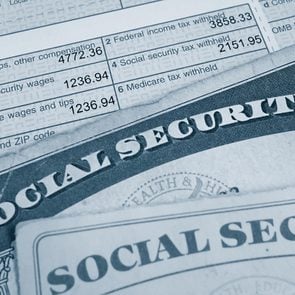Sometimes we make our homes easy targets for burglars. Here's what you need to know to prevent a home invasion.

How Burglars Choose Which Homes to Rob, According to a Criminologist

A masked burglar dressed in ninja black creeps outside your house at night, waiting for the lights to go out so he can make his move—breaking into your home and stealing your valuables while you and your family sleep. Terrifying, right? But this concept of a home invasion is mostly untrue.
Despite Hollywood and cartoon depictions, most burglaries occur during the daytime, according to the FBI’s 2019 Crime in the United States report. This wasn’t always the case, and the change may be due to societal shifts, notes Paul Grattan Jr., a retired sergeant with the New York Police Department (NYPD) and managing director of Graypoint Strategies, a public safety consulting firm.
During the 1950s and ’60s, nighttime burglaries were more common because “a large number of women [were] home during the day,” as fewer women worked outside the home, Grattan says. And burglars prefer to do their work when no one is home. “When it comes to residential theft, almost all present-day burglaries occur when a residence is not occupied,” he says.
Burglaries—which are defined as unlawfully entering a building and removing property—have been declining since the 1980s, Grattan says, and the statistics bear this out. Nevertheless, more than 1,925 home burglaries happen each day in the United States, causing losses valued at an average of about $3,300 and chipping away at your sense of security.
Read on to learn what burglars look for when deciding which house to target—and how to prevent a home invasion from happening to you.
Get Reader’s Digest’s Read Up newsletter for more news, tech, travel, humor and fun facts all week long.
Homes that are safe from prying eyes

If you’re a burglar, the less activity that neighbors or passersby can see from the street, the better. That’s why bad guys look for the following:
- Homes with overgrown bushes or high fences
- Homes without nearby neighbors
- Houses difficult to see from the street
- Houses in the middle of the street, according to home security system manufacturer ADT
- Houses without security cameras
“Anywhere there is an element of comfortability for an offender, there is the increased chance of a crime,” Grattan says. In other words, if a burglar doesn’t have to worry as much about being seen, they are more likely to attempt a break-in.
Best move: Keep your landscaping trimmed, and consider installing security cameras, video doorbells and/or alarm systems.
Unlocked potential
Burglars want to get in (and out of) your home as quickly as possible. Sometimes, homeowners make it easy for them by unintentionally giving them access in the following ways:
- Unlocked doors and windows. You might be surprised that 34% of burglars get in through the front door, according to the National Council on Crime Prevention. “We estimate that between one quarter [and one] half of doors are left unlocked for a significant period of time each day,” says Tatiana Peralta, a spokeswoman for the National Crime Prevention Council.
- First-floor windows with an air conditioning unit. “Generally, if [AC units] are not secured properly, they can be pushed in, making for somewhat easy entry,” Grattan says. “When they’re pushed into the residence, they don’t make too much noise.”
- Fire escapes. “They are often on a less noticeable side of the building, and windows are often left open or unlocked,” Grattan adds.
Best move: Keep all doors and windows locked at all times, and make sure any window-mounted air conditioners are secured. This is probably the easiest way to prevent a home invasion.
Flimsy locks and door frames
In 2017, Oregon TV station KGW surveyed 86 imprisoned burglars about their methods. Some reported kicking doors in. Apparently, this is not just something that happens on TV.
“It’s not typically an offender’s first choice,” Grattan says, but he also notes that doors with flimsy locks, or those made with a hollow core, thin wood or glass can make a door vulnerable to this method of entry.
“One of the key components in a safe door that is difficult to kick in isn’t the door itself but the frame. In almost every burglary I responded to where the door was kicked in, it was the door frame that easily gave way on the inside—with nothing but thin wood that splits when the deadlock is pressed against it with enough force.”
Best move: Install a quality deadbolt lock on every door that leads into the house. Then strengthen your door frames using door-jamb reinforcement plates and kits, Grattan recommends.
Spare keys hidden in obvious spots

You’re not fooling anyone by stashing a key under the doormat or in that planter next to the front door. “Most bad actors will typically take a quick glance around the door and above the door frame, under a mat and inside a nearby mailbox,” Grattan says.
Best moves: Install an electronic door lock in place of one that requires a key. You can assign digital codes to people you want to have access, and they enter their code to unlock the door. Many of these locking systems also have an app that allows you to lock and unlock the door with your phone. If you still feel more comfortable with a physical key, at least use a lockbox with a PIN to secure the key. And if you must hide a key somewhere, Grattan recommends making it a key that opens a rear or side door and finding somewhere less obvious to hide it.
Signs you’re away from home
An unoccupied home is an appealing target to a burglar, particularly if they sense that you won’t be home for hours or even days. Some of the things they may look for include:
- No sound from a TV or radio
- Lights that don’t get turned on and off
- Mail or packages piled up
- Trash bins left on the street
- Snow not cleared from the driveway in the winter
Best moves: Have a trusted neighbor take care of some of these exterior signs of absence. To make it look like you’re home, you might even ask a neighbor to park their car in your driveway from time to time, particularly if you’ll be away for a while. Also, consider adding some “smart” lighting that you can control with an app. As Grattan notes, “this can help randomly change the lighting scheme and make the house appear occupied.”
Signs that you’ve got valuables inside

If your home suggests you’re wealthy, burglars might think they can get a good haul. “The overall picture tells the tale—if it has an expensive car in the driveway, it’s in a higher-end neighborhood, it’s a nice house, etc.,” Grattan says. Other giveaways:
- Expensive items visible in the windows. “We see this more in remote areas where trespassers are exploring a property,” Grattan says. “I know of a case in a vacation home in Vermont where a telescope that was on a tripod visible from the window was the only item stolen from the house—something that juveniles would likely have found desirable.”
- Bumper stickers that disclose the owner’s interests. In the KGW survey, one convicted burglar wrote: “NRA sticker on car bumper = Lots of guns to steal.”
- Your home is in a neighborhood where ethnic stereotypes prevail. Grattan says he saw many cases while on the NYPD where “a particular group of people was [believed] to keep valuables in the residence.” Within some immigrant and ethnic communities, he says, “mistrust in banks is common, and many residents keep large amounts of cash at home. Likewise, many immigrant residents were not able to open proper bank accounts. This presented opportunities in some areas for offenders to score large amounts of cash proceeds from burglary.”
Best moves: Minimize the visibility of any valuables you may have. Keep as little cash as possible in your home, and use a safe for any large amounts of cash that you do keep on hand. Be sure to bolt the safe to a floor or wall, though, since it’s one of the hiding spots burglars always check, and they can just walk away with the safe if it’s not secured.
The bottom line
While there are many things a homeowner can do to prevent burglary, other complex factors—drug issues, economic issues, poverty, etc.—also contribute to the threat.
And not all home invasions are burglaries. The term “home invasion” refers to breaking into someone’s home with the intent to commit a crime while the occupants are present. It can also include robbing a person (“robbery” means taking property from a person by force or threat of force, Grattan says), or even rape.
Learning how to outsmart burglars and prevent a home invasion, Grattan says, “often comes down to making your property less attractive to burglars than the properties nearby.”
About the expert
|
Why trust us
At Reader’s Digest, we’re committed to producing high-quality content by writers with expertise and experience in their field in consultation with relevant, qualified experts. We rely on reputable primary sources, including government and professional organizations and academic institutions as well as our writers’ personal experience where appropriate. For this piece on how to prevent a home invasion, Laurie Budgar tapped her experience as a longtime journalist who covers home safety, technology and scams for Reader’s Digest. We verify all facts and data and revisit them over time to ensure they remain accurate and up to date. Read more about our team, our contributors and our editorial policies.
Sources:
- FBI: “Crime in the United States”
- Paul Grattan Jr., retired sergeant with the NYPD and owner of Graypoint Strategies; email interview Sept. 13, 2024
- FBI: “Crime Data Explorer”
- ADT: “When Do Most Burglaries Occur? Everything You Should Know”
- Tatiana Peralta, communications director for the National Crime Prevention Council
- KTVB: “We asked 86 burglars how they broke into homes”



